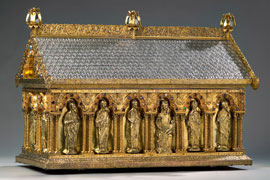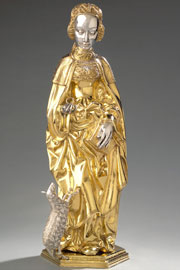Goldsmith’s Art of International Standing Is Coming to Münster
Exhibition “Golden Splendour” rewrites a chapter of Westphalian history

Master Sifridus, Renfridus and Hermannus, Prudentia shrine, Beckum, St. Stephanus, c. 1240
Precious goldsmith’s art of international standing will be coming to Münster in spring 2012 for the exhibition “Golden Splendour”. “We were able to gather more than 240 medieval exhibits from international and national lenders for the extensive exhibition at the LWL State Museum and at the Treasury”, said historian Prof. Dr. Gerd Althoff of the University of Münster’s cluster of excellence “Religion and Politics”. Among them are precious pieces such as the Enthroned Mother of God from Walcourt, the shrine of Mary from Tournai in Belgium and gilded enamel plates from the British Museum. “At the same time, the exhibition is the first to recognise the splendour of Westphalian goldsmith’s art, which had lain dormant for a long time. Their high standard will reveal itself to the audience in comparison with the international first-class works.”

Reliquary figurine of Saint Agnes, Münster Treasury, c. 1520-1525
The exhibition is a cooperation project of the LWL State Museum for Art and Art History of the Regional Association of Westphalia-Lippe (Landschaftsverband Westfalen-Lippe, LWL), the Diocese of Münster and the cluster of excellence “Religion and Politics”. From 26 February to 28 May 2012, on a space of 1,500 square metres and in twelve rooms, they will showcase a total of 300 outstanding goldsmith’s art works from the 10th to the 16th centuries. The curators were able to gather international loans from museums, libraries and churches from across Europe, as LWL curator Dr. Petra Marx and diocesan curator Holger Kempkens explained. The works come from Switzerland, France, Belgium, the Netherlands, Great Britain and Finland. 220 loans come from Germany, 180 of these from Westphalian churches, monasteries, archives and museums. The LWL State Museum and the Treasury themselves contribute 60 outstanding exhibits.
The Late Middle Ages as a cultural heyday
The exhibition rewrites a part of Westphalian history, as Althoff explained. “The Late Middle Ages do not present themselves here as an age of decline but as a cultural heyday: a self-confident middle class donated high-quality crosses, chalices or shrines out of deep piety. Some stereotypes about the provinciality of Westphalians can be jettisoned in the light of the ‘Golden Splendour’.” According to Marx, the Cappenberg head of Barbarossa (probably the first portrait of the Middle Ages), the Borghorst reliquary cross (which was recently on exhibition in London) and the unique silver figurines such as that of Saint Agnes from the Münster Cathedral Treasury are evidence of the goldsmiths’ artistry.
“We are taking many pieces out of the shadows for the first time”, said diocesan curator Holger Kempkens. “For example, the apostle figurines from the high altar of Münster Cathedral will be on public display for the first time in decades. Other works such as the Sifridus chalice from Borga in Finland, which disappeared from the Osnabrück Treasury during the Thirty Years’ War (1618-1648), can rarely be admired in Germany.” According to Marx, the exhibition presents, on the one hand, sacred pieces such as the oldest monstrance in the world, which comes from Herkenrode Abbey in Belgium. On the other hand, it presents most precious items for secular purposes such as the unique silver of the Osnabrück council or filigree jewellery for the urban clientele.
The Westphalian objects are each contrasted with international ones in the exhibition. Thus, Kempkens said, not only the international artistic influences on the Westphalian art can be detected, but also the high quality of the objects: “The Prudentia shrine from Beckum, produced by local goldsmiths, will shine right next to the famous shrine of Our Lady from Tournai, which comes from the famous studio of Nicholas of Verdun, the artificer of the Shrine of the Three Kings in Cologne Cathedral.” Gold was the most precious material of the Middle Ages: “Whether the donators were noble or middle-class: only the best was good enough when God and the saints were to be honoured”, said historian Althoff. Curator Marx added: “Its celestial shine made it an allegory of the eternal, the holy and the divine, and conveyed the heavenly glory to the people.” Thus, the goldsmiths’ works, to which silver and gemstones were often added, became evidence of Christian piety and secular needs for representation.
The historical identity of the region
At first, the most important places of production in Westphalia were the diocesan towns of Münster, Paderborn and Osnabrück, as well as the Benedictine monastery of Corvey and the Abbey of Essen, as the exhibition will illustrate according to curator Kempkens. As of the 13th century, the works were increasingly produced in the blooming Hanseatic cities of Soest and Dortmund. Historian Althoff: “The emergence of this golden splendour is an important aspect of the history of Westphalia that has so far hardly been taken up, and it can strengthen the historical identity of the region as do the memory of the victory over the Romans and of the Peace of Westphalia.”
The trademark of the exhibition “Golden Splendour” is the interdisciplinary approach resulting from the collaboration of the museums with the cluster of excellence, combining art historical, historical and theological perspectives. Thus, the exhibition illustrates the artistic standing of the works just as it illustrates the historical and social environment in which they were made, supplementing the goldsmiths’ art with sculptures, panels, illuminations and liturgical vestments. In addition to written documents, they demonstrate the artistic standing, the symbolism and the complex meaning of the goldsmiths’ works. (vvm/ska)
"Golden Splendour. Medieval Treasures in Westphalia": 26 February to 28 May 2012 at the Westphalian State Museum of Art and Cultural History (LWL) and in the Cathedral Treasure Chamber of the diocese of Münster

